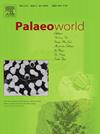The early Holocene vegetation history and quantitative reconstruction of climate in the Chahanur Lake, Inner Mongolia Plateau, China
IF 1.7
3区 地球科学
Q2 PALEONTOLOGY
引用次数: 0
Abstract
Vegetation is sensitive to climate change, and lake sediments store much information about palaeovegetation. Although environmental information has been recorded for most of the world’s lakes, some vegetation and climate history inconsistencies have persisted since the Holocene due to large regional differences. In this study, sediment samples were collected from Chahanur Lake on the Inner Mongolia Plateau, the dating sequence of the samples was determined by Accelerator Mass Spectrometry (AMS) 14C dating, and the vegetation history was reconstructed using the biome method and the climate was reconstructed using the weighted averaging partial least squares (WAPLS) method. Vegetation and climate history were systematically analysed. The results showed that the profile age of the lake was 11438–7918 cal. yr BP. During the early Holocene, vegetation evolved from sparse forest steppe (11438–10092 cal. yr BP) to broad-leaved forest steppe (10092–9288 cal. yr BP), and finally to the sparse forest steppe (9288–7918 cal. yr BP). Climate changed from cold and dry during 11438–10092 cal. yr BP, to warm and wet between 10092 and 9288 cal. yr BP, then warm and dry from 9288 to 7918 cal. yr BP. The reconstruction of palaeovegetation and palaeoclimate indicates increased precipitation during the early Holocene on the Inner Mongolia Plateau. This supports previous studies on palaeovegetation and enriches the Holocene pollen database.
内蒙古高原察哈努尔湖早全新世植被史与气候定量重建
植被对气候变化很敏感,湖泊沉积物储存了很多关于古植被的信息。尽管世界上大多数湖泊的环境信息已被记录下来,但由于区域差异很大,一些植被和气候历史的不一致性自全新世以来一直存在。本研究采集了内蒙古高原察哈努尔湖沉积物样品,采用加速器质谱(AMS) 14C测年法确定了样品的年代序列,采用生物群系法重建了植被历史,采用加权平均偏最小二乘(WAPLS)法重建了气候。系统地分析了植被和气候历史。结果表明,该湖剖面年龄为11438 ~ 7918 cal. yr BP。在全新世早期,植被由疏林草原(11438 ~ 10092 cal. yr BP)演变为阔叶林草原(10092 ~ 9288 cal. yr BP),最后演变为疏林草原(9288 ~ 7918 cal. yr BP)。在11438 ~ 10092 cal. yr BP期间,气候由寒冷干燥转变为温暖潮湿,在10092 ~ 9288 cal. yr BP期间又转为温暖干燥。古植被和古气候的重建表明,内蒙古高原早全新世降水增加。这支持了前人对古植被的研究,丰富了全新世花粉数据库。
本文章由计算机程序翻译,如有差异,请以英文原文为准。
求助全文
约1分钟内获得全文
求助全文
来源期刊

Palaeoworld
PALEONTOLOGY-
CiteScore
4.00
自引率
5.90%
发文量
95
期刊介绍:
Palaeoworld is a peer-reviewed quarterly journal dedicated to the study of past life and its environment. We encourage submission of original manuscripts on all aspects of palaeontology and stratigraphy, comparisons of regional and global data in time and space, and results generated by interdisciplinary investigations in related fields. Some issues will be devoted entirely to a special theme whereas others will be composed of contributed articles. Palaeoworld is dedicated to serving a broad spectrum of geoscientists and palaeobiologists as well as serving as a resource for students in fields as diverse as palaeobiology, evolutionary biology, taxonomy and phylogeny, geobiology, historical geology, and palaeoenvironment.
Palaeoworld publishes original articles in the following areas:
•Phylogeny and taxonomic studies of all fossil groups
•Biostratigraphy, chemostratigraphy, chronostratigraphy
•Palaeoecology, palaeoenvironment and global changes throughout Earth history
•Tempo and mode of biological evolution
•Biological events in Earth history (e.g., extinctions, radiations)
•Ecosystem evolution
•Geobiology and molecular palaeobiology
•Palaeontological and stratigraphic methods
•Interdisciplinary studies focusing on fossils and strata
 求助内容:
求助内容: 应助结果提醒方式:
应助结果提醒方式:


